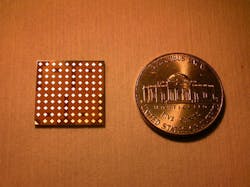Integrated Circuit Tackles Mobile Communications Issues
The recent, exponential growth of the capabilities and sophistication of mobile devices has been almost fully supported by the integration of advanced radio frequency (RF) communications capabilities. Reaching into millimeter-wave bandwidths greatly expands opportunities for small cell infrastructure, mobile backhaul, and data deployment thanks to those bandwidths being able to support gigabytes of wireless communications.
A new millimeter-wave phased-array transceiver has been developed with four chips and 64 antennas to help solve high-data-rate communications and advanced-resolution radar imaging challenges. The transceiver, unveiled by IBM Labs, operates at frequencies between 90-94 GHz and has beamforming capabilities enabled by hundreds of antenna elements, which allows for communications extending over a range of kilometers.
Each of the four phased array integrated circuits (ICs) uses 32 receiver and 16 transmit elements with dual outputs to support 16 dual polarized antennas. Each IC is designed using IBM’s silicon-germanium (SiGe) semiconductor process, enabling them to integrate frequency synthesis and conversion as well as digital control functions. Multiple operating modes are supported and the system is completely scalable, with the entire form smaller than an American nickel.
A future application of IC technology includes high-resolution radar imaging thanks to its short wavelength, relatively low atmospheric attenuation, and capability of penetrating debris. Ultimately, it could be used in the scaling down of radar technology which would give pilots the ability to see through obstructions such as fog and dust. IBM’s project was partially funded by the Defense Advanced Research Projects Agency (DARPA) Strategic Technology Office (STO).
About the Author
Iliza Sokol
Associate Digital Editor
Iliza joined the Penton Media group in 2013 after graduating from the Fashion Institute of Technology with a BS in Advertising and Marketing Communications. Prior to joining the staff, she worked at NYLON Magazine and a ghostwriting firm based in New York.
